Signatures and date codes
used by Karl Martz
on the pottery he made.
Feedback to
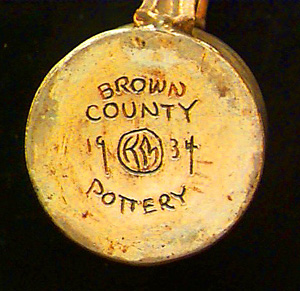
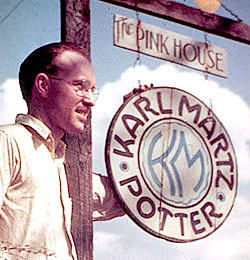 Most photographs of pots on this page were taken by Eric Martz in 2001
from pots in his possession. These pots were given to Eric by Karl
and Becky prior to Karl's death in 1997, and hence are known
to be authentic. Some photos provided by others are judged to
be of authentic Karl Martz pots based on the signature, style of the
pot, and quality of work.
Click on the bottoms to see the tops and other information
about individual pots!
Most photographs of pots on this page were taken by Eric Martz in 2001
from pots in his possession. These pots were given to Eric by Karl
and Becky prior to Karl's death in 1997, and hence are known
to be authentic. Some photos provided by others are judged to
be of authentic Karl Martz pots based on the signature, style of the
pot, and quality of work.
Click on the bottoms to see the tops and other information
about individual pots!
|
Signatures Illustrated Below:
|
Elsewhere:
|
Ceramics signed only "Martz" or "MARTZ" (no first name) are usually
by Gordon Martz and Jane Marshall Martz.
Their older pieces usually have letter-number codes
(examples).
Works by Karl Martz usually have his full name, his initials KM (usually
stylized in a circle as shown below), or "Martz Studio" (which was never used
by Gordon and Jane [personal communication with Jane Marshall Martz, 2002]).
"Martz Studio" signatures that include an overlapping BB are by Becky Brown
(examples).
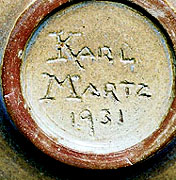
|
Karl first studied ceramic art at Ohio State University in the summer
of 1931 (more).
|
In 1934,
while an apprentice at the Brown County Pottery,
Karl began signing his pots with his initials "KM" fitted into a
circle. (Neither Karl, nor his father, nor his sons were given
middle names.) When Karl and Becky set up the
Karl Martz Studio in 1936,
he continued using the circled KM, and this remained his primary
signature throughout his career.
|
Even after he began using the circled KM, he sometimes simply wrote
"Karl Martz" in block print, as shown in this example from the Brown County
Pottery in 1935,
or in script (far right, ca. 1940).
(Compare with the earlier 1934 example above that includes
a circled KM.)
|
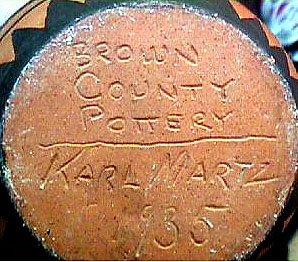
|
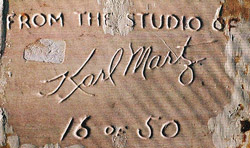
|
First Kiln
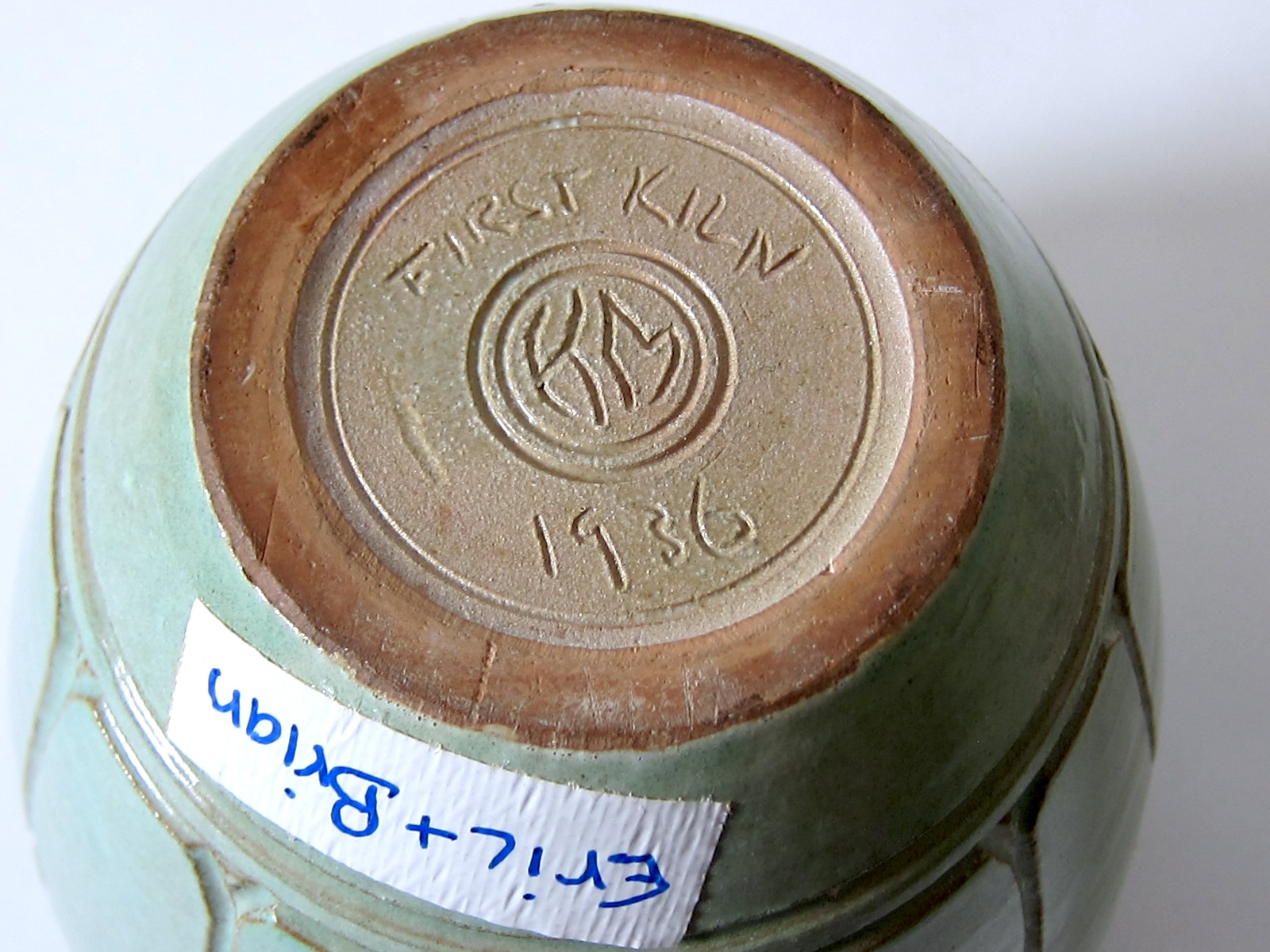
|
In 1936, at the
Batchfield Cabin, Karl built his first kiln.
|
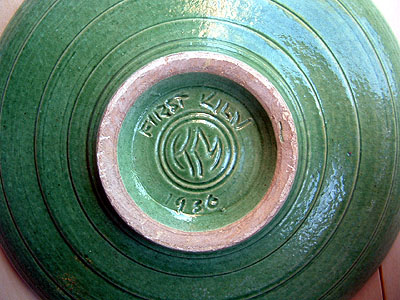
|
1940s & 1950s
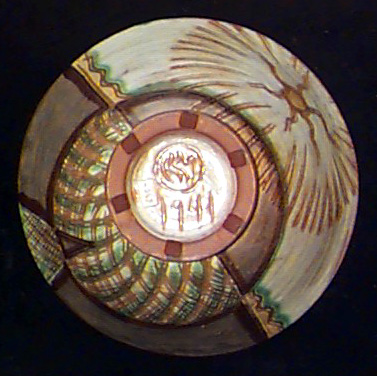
|
Here are two circled KM examples from the 1940's.
|
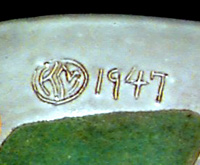
|
|
Beginning about 1950, Karl and Becky began including
"Martz Studio" on their pots. This referred to the
studio they built
in Brown County.
Pots signed with the circled KM were made, decorated and glazed
by Karl; pots
signed BB or Becky Brown were made, decorated and glazed
by Becky Brown.
Pots signed simply "Martz Studio" were worked on by both of them.
|
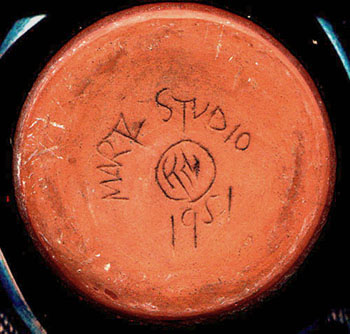
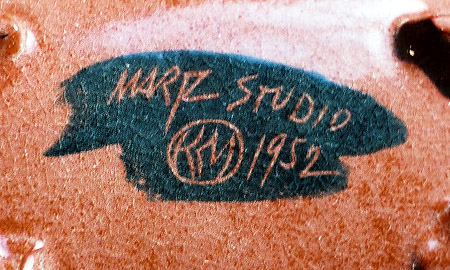
|
Jugtown
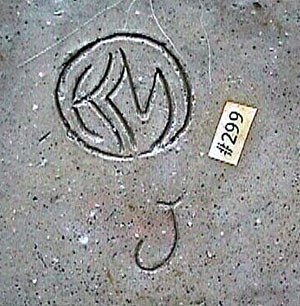 In 1957, Karl visited the traditional Jugtown Pottery in North
Carolina for about 10 days, during which
he made a number of salt-glazed
pots. Most have a "J" near the signature.
Click the signature to see some of these pots
and a link to Karl's account
of his visit.
In 1957, Karl visited the traditional Jugtown Pottery in North
Carolina for about 10 days, during which
he made a number of salt-glazed
pots. Most have a "J" near the signature.
Click the signature to see some of these pots
and a link to Karl's account
of his visit.
(See serial numbers on paper rectangles.)
1960s-1980s: Undated
From about 1960 through the early 1980's, Karl often omitted
the year on his pots
(see Dates and year codes).
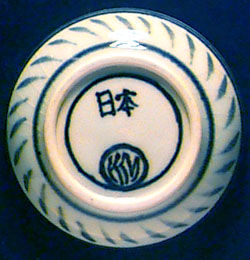
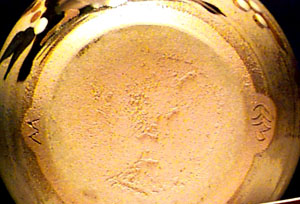
Kyoto: Some pots made during
his sabbatical to Kyoto, Japan in 1963-64 (see timeline) were signed with a circled
KM plus japanese characters meaning "Japan" (Nippon -- country of the rising
sun).
Mashiko: Some pots made during his sabbatical in Mashiko, Japan, in 1971-72
were signed with KM (no incised circle) on one side near the foot,
plus an "M" (for Mashiko) on the opposite side near the foot.
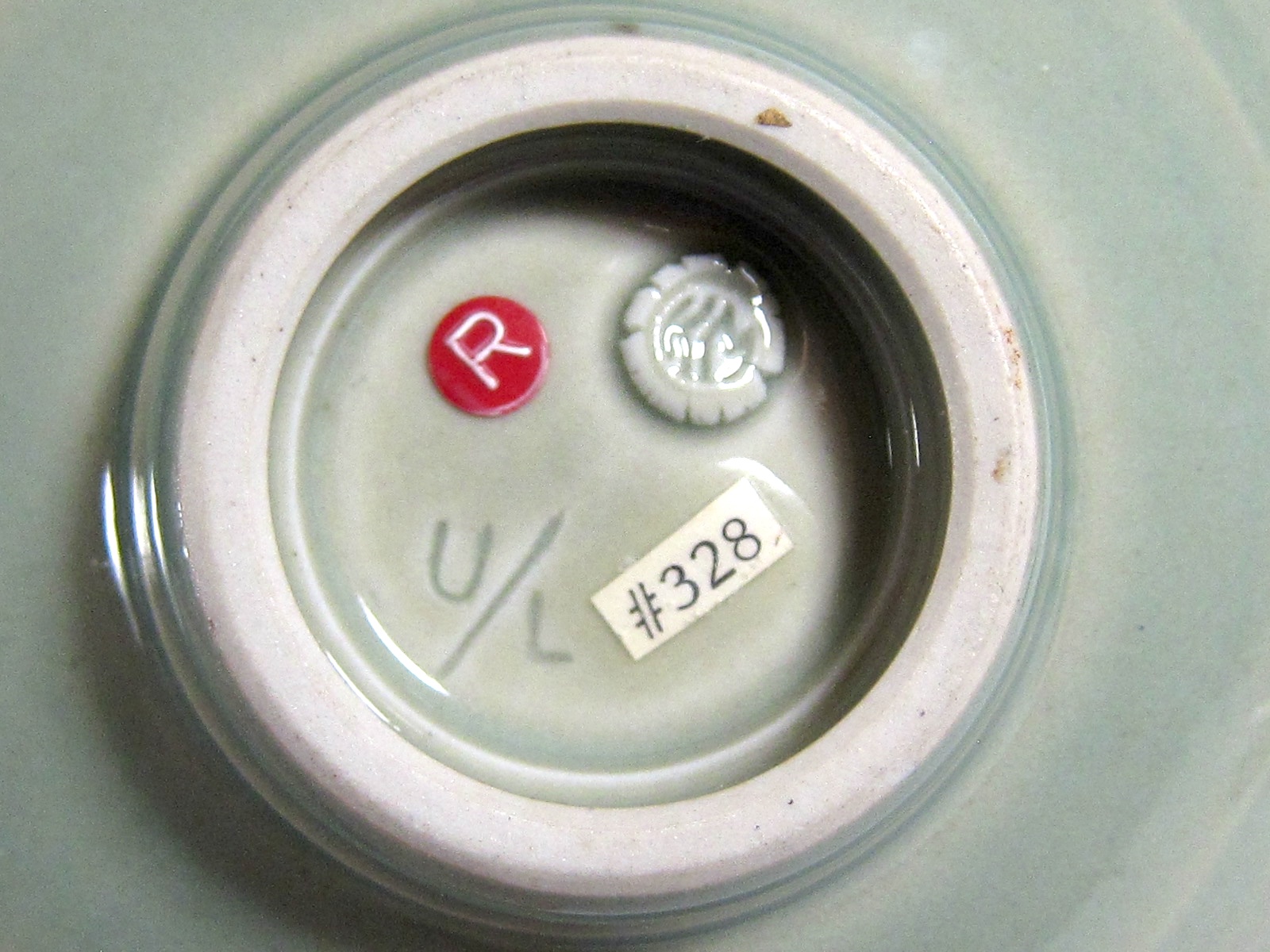 University of Louisville:
Pieces made in 1975 while Karl was Bingham Professor of the Humanities at the
University of Louisville (Kentucky) may be marked "U/L".
University of Louisville:
Pieces made in 1975 while Karl was Bingham Professor of the Humanities at the
University of Louisville (Kentucky) may be marked "U/L".
|
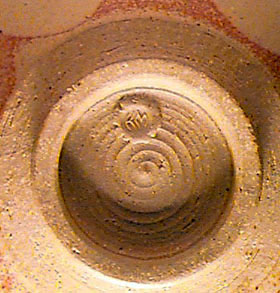 Stamped Signatures:
Through the 1950's, Karl typically incised the circled KM
into the clay by hand, with a sharp metal stylus. Probably in the
1960's, he began making signature stamps from fired clay, with
which the signature was impressed into the still-plastic foot.
The stamping tools were often passed through more than one cycle of
positive and negative stamping, drying and firing, resulting
in substantial shrinkage and miniaturization. Sometimes,
the stamp was made in a small ball of clay pressed onto the surface
of the pot, as shown at right.
Stamped Signatures:
Through the 1950's, Karl typically incised the circled KM
into the clay by hand, with a sharp metal stylus. Probably in the
1960's, he began making signature stamps from fired clay, with
which the signature was impressed into the still-plastic foot.
The stamping tools were often passed through more than one cycle of
positive and negative stamping, drying and firing, resulting
in substantial shrinkage and miniaturization. Sometimes,
the stamp was made in a small ball of clay pressed onto the surface
of the pot, as shown at right.
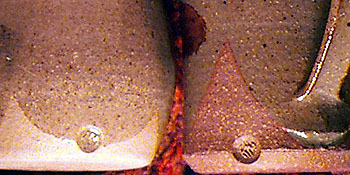 The circled KM was typically on the bottoms of the pots
through the 1950's. Later, on upright forms, he often put the signature low on
the side.
The circled KM was typically on the bottoms of the pots
through the 1950's. Later, on upright forms, he often put the signature low on
the side.
Alternative Signatures
|
Beginning probably in the 1970's, Karl used alternative
signatures on some pots. He began reserving his circled KM cachet for his
more impressive "show" pieces. He continued to enjoy making simple
utilitarian mugs, pitchers, bowls, and covered jars, and
these were sometimes signed with a plain "KM" (not circled),
"CP" for "Clayburn Pottery", "Studio M", or "Kiln Haus".
The latter three were
typically stamped with ceramic stamps that Karl made.
|
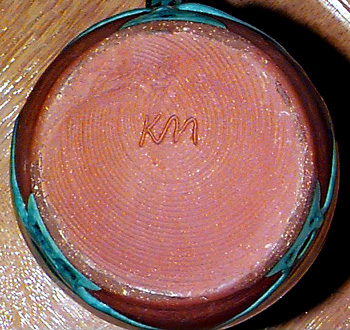
|

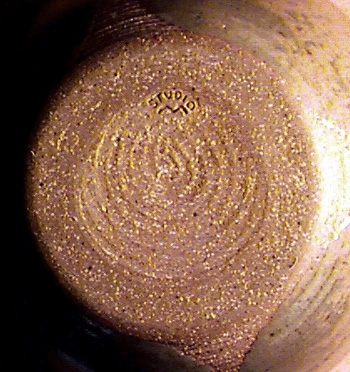

|
Dates and Year Codes

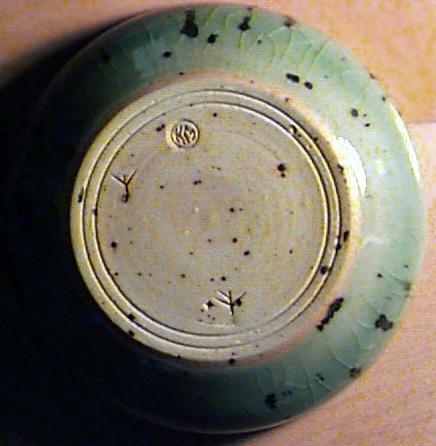 Through the 1950's Karl usually included the year on the bottoms
of the pots. Around 1960, he decided he would rather not reveal
the actual year he made a pot, so that would not be an issue
when work was submitted to shows. Probably most of his
pots made in the 1960's and
1970's were undated.
Through the 1950's Karl usually included the year on the bottoms
of the pots. Around 1960, he decided he would rather not reveal
the actual year he made a pot, so that would not be an issue
when work was submitted to shows. Probably most of his
pots made in the 1960's and
1970's were undated.
About 1982, Karl adopted a cuneiform
code for indicating the year, and also the clay body serial number of each pot
within the year. During his lifetime, these codes were secret so that when he submitted
works to shows, they did not know in which year he made the submitted works.
In order to read these codes, one should orient the
circled KM at the top. The year will then be at the left, and the
serial number at the bottom.
Using the chart below, it can be seen that the pot at the right
was made in 1987, and was the 18th clay body he made that year. (Sometimes,
clay bodies were not glazed and fired until later years.)
Karl probably began coding dates after 1985. In the early 1990's, Karl
gave a verbal description of his secret coding system to son Eric,
who made written notes. There are a few uncertainties, but
the general scheme is clear. The variations shown below are Eric's
guesses from his written notes -- perhaps not all these variations were
actually used. In his symbols for the digits 6 through 9, it was
immaterial whether the branches extended to the right, to the
left, or both, and whether they angled up or down.
The first year, Karl indicated only the serial number for that
year, but not the year.
Example.
It is not certain what the "first year"
was.
The earliest year for which
we have an example is 1987 (see list of examples below). Thus, the first year might
have been as late as 1986.
(We would appreciate receiving photos of Karl's pots with examples
of cuneiform date codes earlier than 1987.)
After the first
year, he began indicating the second digit of the year (e.g. "7"
for 1987, "9" for 1989) plus the serial number. Two cases are known
in which 1990 was indicated with a horizontal bar (for the digit
zero, see below). Whether all 1990 pots were indicated
consistently in this way is not certain.
Beginning in 1991, both digits of the year are indicated.
1992 may have been the last year Karl made pots. Three examples
are known coded 1992 (see below). If anyone knows of
a pot coded later than 1992, please let me know.
The year and serial number were assigned at the time the body was made. In
some cases, glazing and final firing may have been completed
a year or more later.
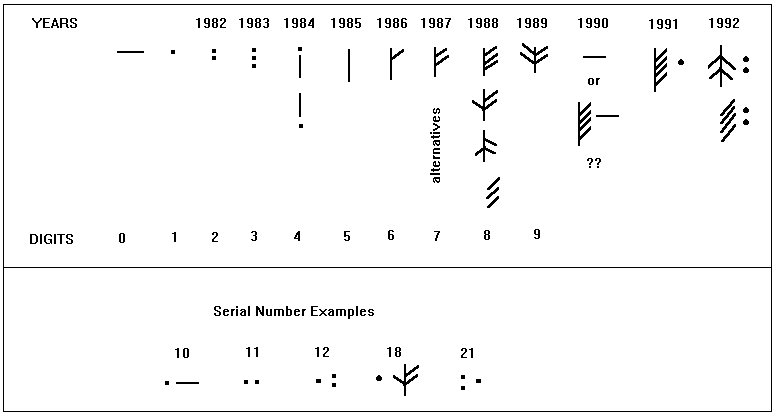 Digit codes (illustrated above):
Digit codes (illustrated above):
- 1, 2, 3: One, two, or three dots, respectively, arranged vertically.
In some cases, horizontal or slanted parallel bars instead of dots
(see examples below at 1987 body 13, 1990, 1992).
- 4: A vertical bar with a dot, either above or below the bar.
- 5: A vertical bar.
- 6, 7, 8, 9: A vertical bar with branches on either side, slanting
up or down from the "trunk". The trunk counts 5, to which is added the
number of branches. In some cases the vertical bar is omitted and only
the branches are shown. Branches mean the same (one each) regardless
of whether slanting up or down, and regardless of which side of the
trunk they are on. In some cases, dots by the side of a vertical line were
substituted for branches.
- 0: A horizontal bar.
Examples:
- 1978 (year in plain numerals):
No body serial number #1,
No body serial number #2.
- 1979 (year in plain numerals):
Body 3,
No body serial number.
- First year (1986?):
Body 18,
Body 21,
Body 30,
Body 40.
- 1987:
Body 6,
Body 13,
Body 18,
Another Body 18,
Body 54,
Body 57,
- 1988:
Body 2,
Body 4,
Body 8,
Body 36.
- 1989:
Body 7,
Body 17,
Body 22.
- 1990:
Body 36.
- 1991:
Red Goblets.
- 1992:
Bodys 2 and 5,
Body 15.

 Most photographs of pots on this page were taken by Eric Martz in 2001
from pots in his possession. These pots were given to Eric by Karl
and Becky prior to Karl's death in 1997, and hence are known
to be authentic. Some photos provided by others are judged to
be of authentic Karl Martz pots based on the signature, style of the
pot, and quality of work.
Click on the bottoms to see the tops and other information
about individual pots!
Most photographs of pots on this page were taken by Eric Martz in 2001
from pots in his possession. These pots were given to Eric by Karl
and Becky prior to Karl's death in 1997, and hence are known
to be authentic. Some photos provided by others are judged to
be of authentic Karl Martz pots based on the signature, style of the
pot, and quality of work.
Click on the bottoms to see the tops and other information
about individual pots!

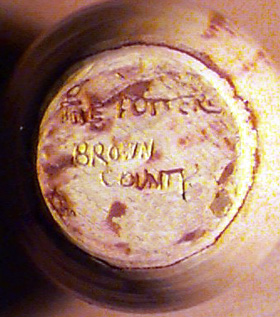
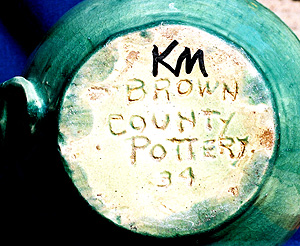












 Stamped Signatures:
Through the 1950's, Karl typically incised the circled KM
into the clay by hand, with a sharp metal stylus. Probably in the
1960's, he began making signature stamps from fired clay, with
which the signature was impressed into the still-plastic foot.
The stamping tools were often passed through more than one cycle of
positive and negative stamping, drying and firing, resulting
in substantial shrinkage and miniaturization. Sometimes,
the stamp was made in a small ball of clay pressed onto the surface
of the pot, as shown at right.
Stamped Signatures:
Through the 1950's, Karl typically incised the circled KM
into the clay by hand, with a sharp metal stylus. Probably in the
1960's, he began making signature stamps from fired clay, with
which the signature was impressed into the still-plastic foot.
The stamping tools were often passed through more than one cycle of
positive and negative stamping, drying and firing, resulting
in substantial shrinkage and miniaturization. Sometimes,
the stamp was made in a small ball of clay pressed onto the surface
of the pot, as shown at right.







